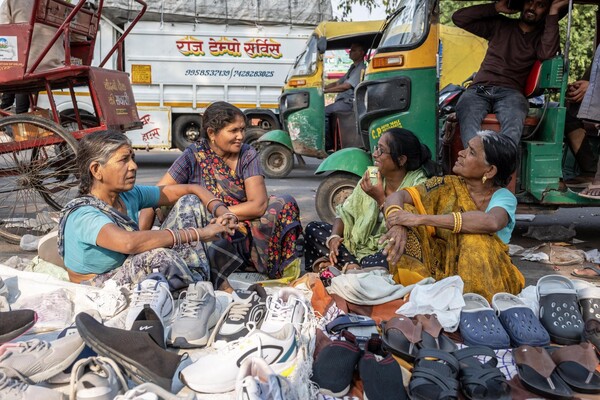
Image: Andriy Onufriyenko via Getty Images
5 min. read
Shortly after Penn alum Timethius Terrell joined the Penn Center for AIDS Research (CFAR)’s Community Advisory Board (CAB), he began thinking of new, budget-friendly ways to foster collaboration between HIV/AIDS researchers at Penn and abroad. Drawing from his experience with nonprofit leadership, Terrell launched Red Ribbon Connect, a monthly virtual session for local and international HIV/AIDS researchers to exchange knowledge, insights, and progress.
The program, which kicked off in April and requires no CFAR CAB budget, is a timely response to worldwide divestment from HIV/AIDS funding in recent years. The CAB fosters relationships and transparent communication between Penn CFAR researchers and the broader public; it also promotes HIV/AIDS education, prevention, treatment, and research that responds to evolving community needs. During an era with urgent need for international research collaboration, Red Ribbon Connect invokes Penn’s strategic framework, In Principle and Practice, by accelerating innovative pursuits and deepening the University’s connection with researchers globally.
Terrell, who graduated from Penn’s College of Arts & Sciences in 2024 with a bachelor’s degree in psychology and a minor in linguistics, has had peers diagnosed with HIV and AIDS—and has felt the tangible impact from decades of progress in this field.
“I know what it’s like to be on the receiving end of this advocacy and receive this research and to benefit from it all,” says Terrell, currently a visiting scholar based in Thailand at the Mahidol University Institute for Population and Social Research.
As a Penn student, Terrell was a fellow at the Office of Social Equity and Community, Perry World House, and the Institute for Urban Research. He also held leadership roles with several Cultural Resource Centers and studied abroad in Thailand. This set of experiences prepared him to lead Red Ribbon Connect and helped shape his desire to promote research collaboration on a global scale.
The primary intent behind Red Ribbon Connect is to “simultaneously help expand—on the U.S. side—an idea of what HIV and AIDS research and advocacy is, to learn from other perspectives,” Terrell explains, while also providing researchers from other countries with “the wealth of expertise that we have been able to build [at Penn].”
Red Ribbon Connect is designed to fit into the CFAR CAB’s existing infrastructure. A block of time is reserved during monthly CAB meetings for selected presenters from Penn and around the world to exchange research, perspectives, and best practices.
It’s also structured to facilitate creative problem solving. Participants discuss localized approaches and challenges for HIV/AIDS treatment and prevention, generating new ideas in the process—all with the goal of bringing better care back home to patients and their communities.
“With each exchange, you don’t really know what it’s going to trigger in someone, or what idea it could bring about,” says Amy Onorato, community engagement coordinator at Penn CFAR CAB and project manager for Red Ribbon Connect. “I’m very much looking forward to that and seeing how we can implement some things that go to serve the HIV community.”
During the inaugural Red Ribbon Connect session, Dusita Phuengsamran, assistant professor at the Mahidol University Institute for Population and Social Research, shared a presentation that Onorato described as eye-opening for the CAB.
“There were a lot of questions about the impact that [the professor’s] program and their lack of funding is having,” says Onorato, noting how the monthly exchange “starts getting people to think differently.”
Onorato’s involvement with the HIV/AIDS field is deeply personal. She has lost several friends to HIV and AIDS. Furthermore, while in college, Onorato helped organize a group that educated students on safe sex practices, raised awareness for HIV/AIDS research, and addressed the social stigma attached to these diseases.
Now, as project manager, Onorato provides administrative support and helps Terrell—as project lead—to align his proposed ideas with CFAR CAB objectives.
“[Red Ribbon Connect] speaks exactly to our CAB mission and vision and brings it to an international level,” says Onorato, citing how the program empowers open communication between researchers, doctors, advocates, and community members.
“For a new and younger person to come on the CAB with all of these ideas and energy is so refreshing for me,” Onorato adds.
Terrell has two main criteria for selecting Red Ribbon Connect presenters. He looks for HIV/AIDS researchers with sufficient academic expertise in their proposed topics and a track record of community engagement.
“I’m looking at their public profiles. I’m looking at their publications, and whether their publications are community-focused,” Terrell says.
Terrell seeks scholars who take participatory approaches to research; in other words, investigators who involve communities most affected by a research topic at various stages of the research process, from problem ideation to sharing results. He also looks for those who strive to make their findings widely accessible for public usage.
For example, Terrell is planning a Red Ribbon Connect session with a Ph.D. student-researcher—based in Australia and originally from the Philippines—who is a community-oriented practitioner and educator focused on mental health.
“They might not be a professor with decades of experience in research, [but] they have unique perspectives that we will learn a lot from,” Terrell says.
Through Red Ribbon Connect, Terrell is building a global roster of action-oriented physician-scientists who actively seek to put their learnings into practice.
“We’re getting people who intend to bring insights directly back to their communities,” Terrell says.
One way that Terrell and Onorato plan to expand Red Ribbon Connect is by sharing program results, impact, and data with other university-based Centers for AIDS Research across the U.S. First, they’re developing methods of measuring program success. Then, once equipped with this data, Terrell can encourage other institutions to implement their own versions of Red Ribbon Connect.
“[If] these exchanges lead to different kinds of collaboration, different kinds of projects in the future... that, for me, would be successful,” Terrell says.
Onorato notes that she and Terrell aim to further integrate social considerations into Red Ribbon Connect programming. This could mean platforming researchers who study how factors like housing, gender, food security, economic status, access to healthcare, ethnic background, etc., can shape outcomes for patients with HIV/AIDS.
“There are many different approaches that can be learned just from educating ourselves about how different communities are dealing with HIV,” Onorato says.
As Terrell works to scale and optimize Red Ribbon Connect, he is equipped with skills gained and values instilled through his extracurricular leadership at Penn.
“The University was founded to train people who can become servants to society, who can make the world a better place,” Terrell says. “As an alum, I’m actively putting into practice the skills I learned at Penn to try to improve the world.”
Despite setbacks in research funding worldwide, Terrell, Onorato, and colleagues remain determined to promote global teamwork on the path to a world free of HIV/AIDS.
“The only way to prevent, to eradicate, to eventually cure HIV and AIDS, is to look at it from different angles and to have people in the same room not just talking, but actively putting their brains together to figure out what that looks like in these different cases,” Terrell says. “And Red Ribbon Connect is meant to be that platform.”

Image: Andriy Onufriyenko via Getty Images

Four women street vendors sell shoes and footwear on a Delhi street.
(Image: Kannagi Khanna)

nocred

nocred